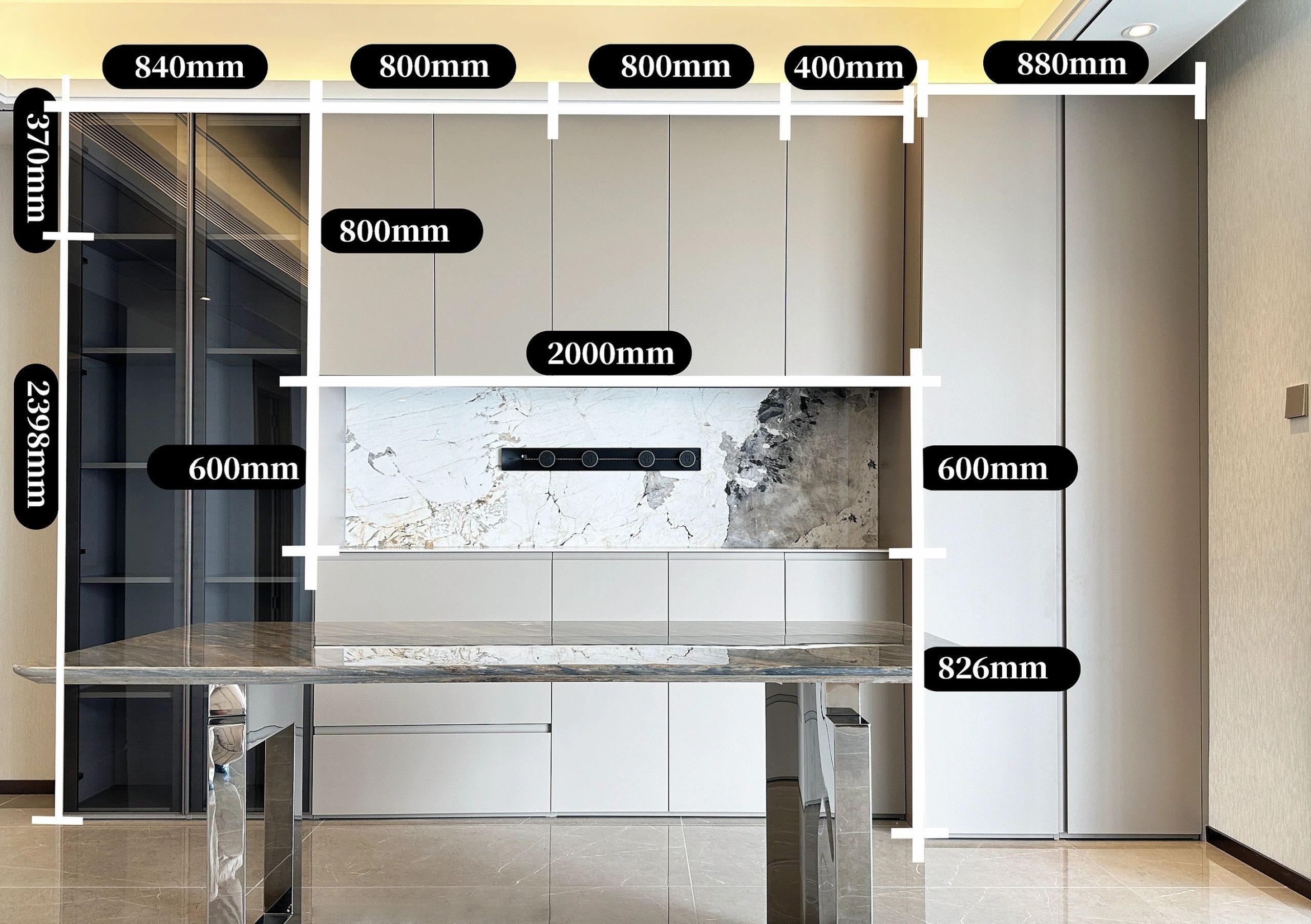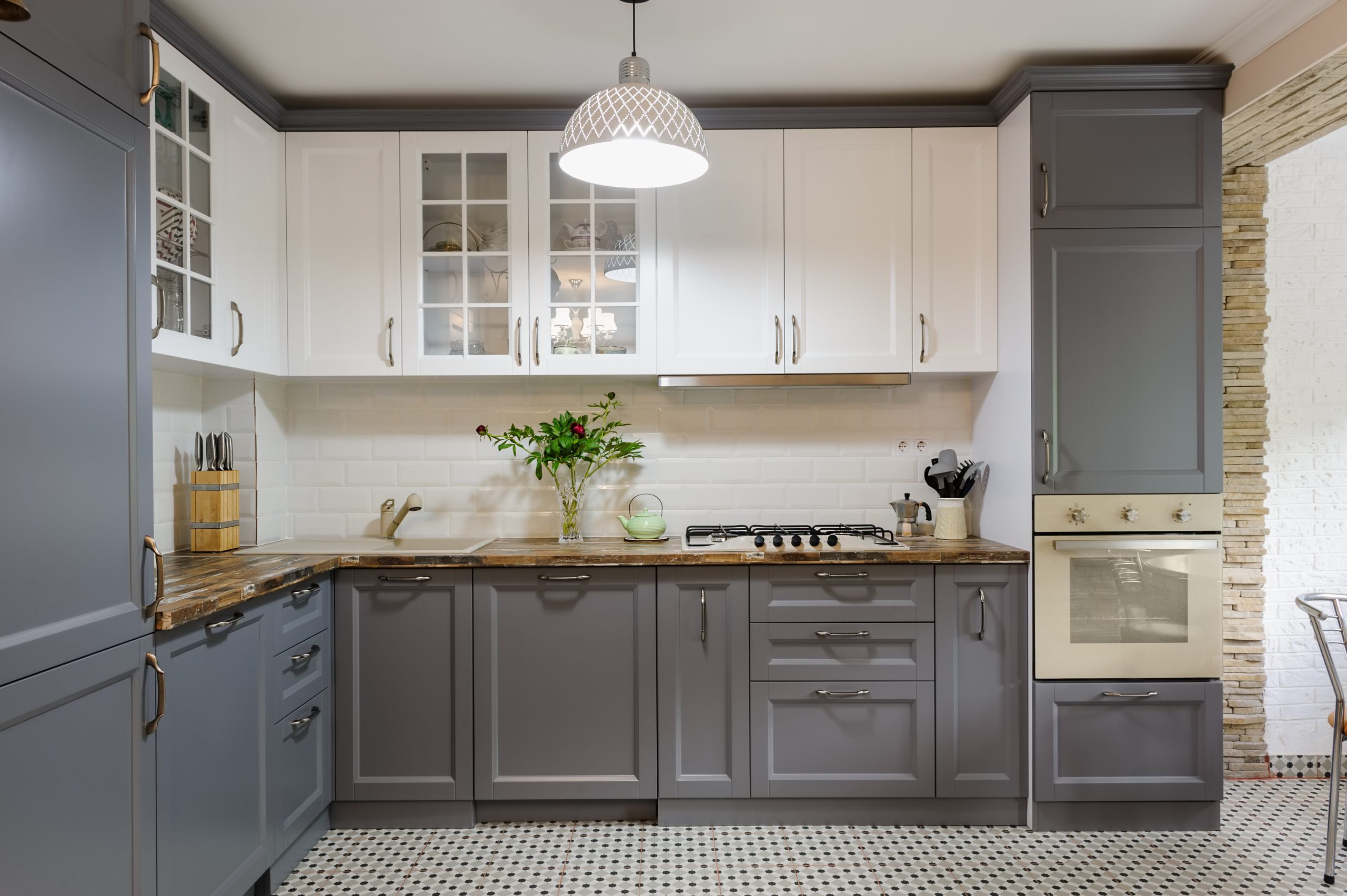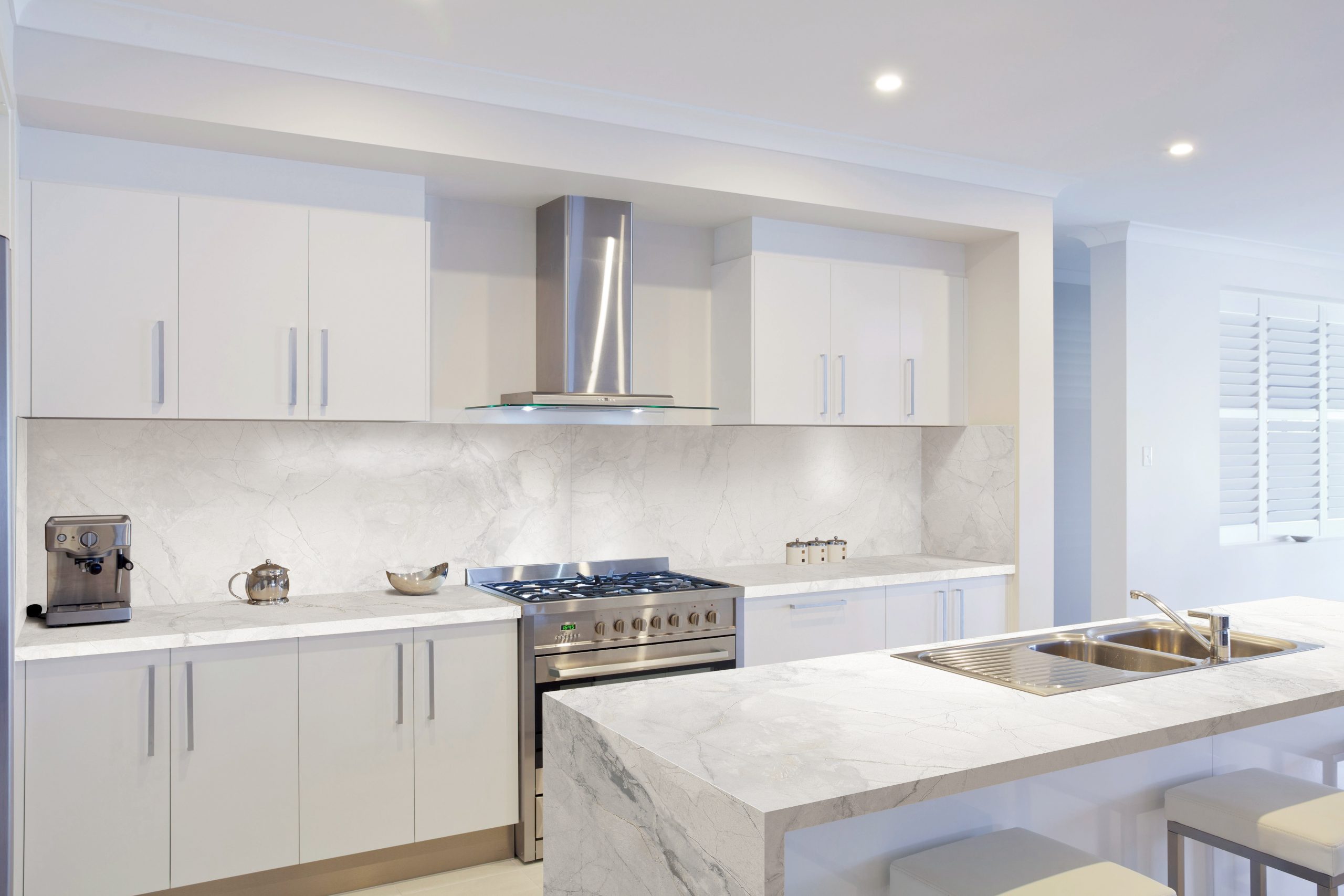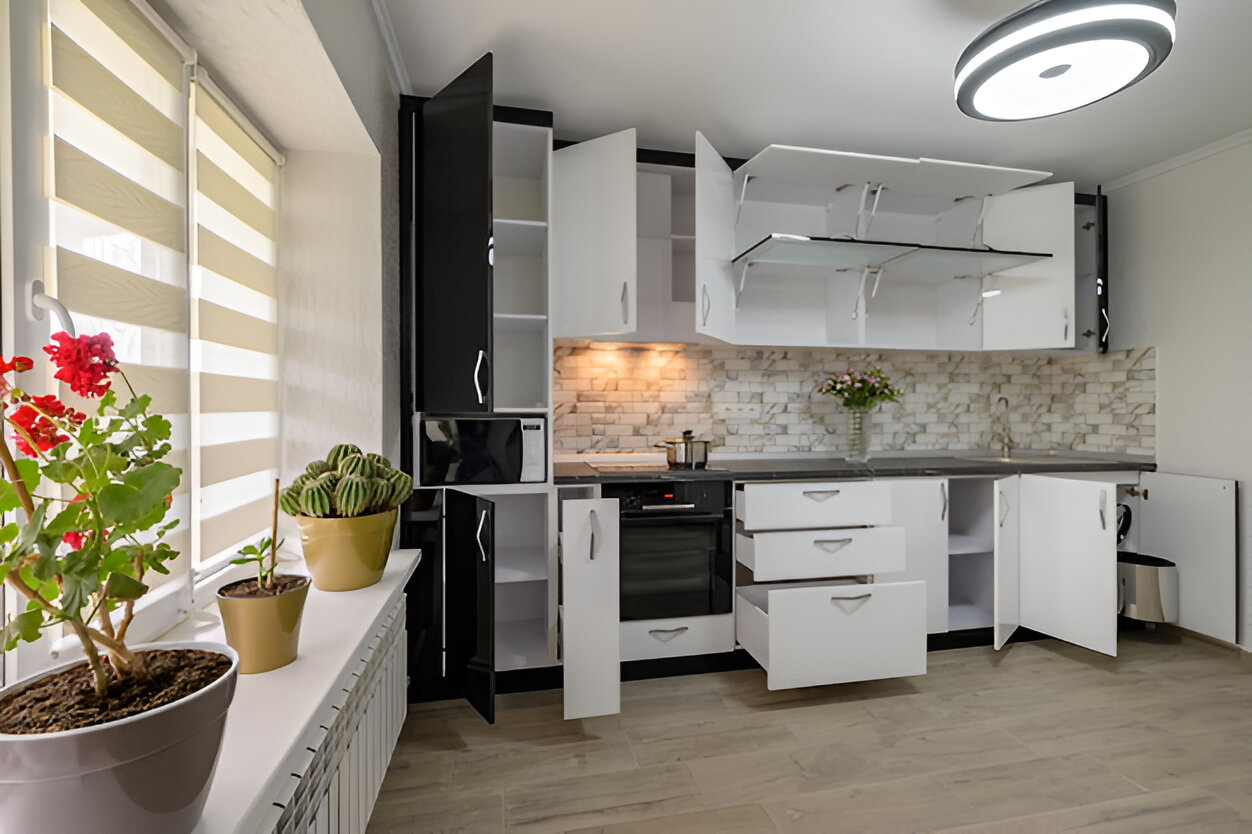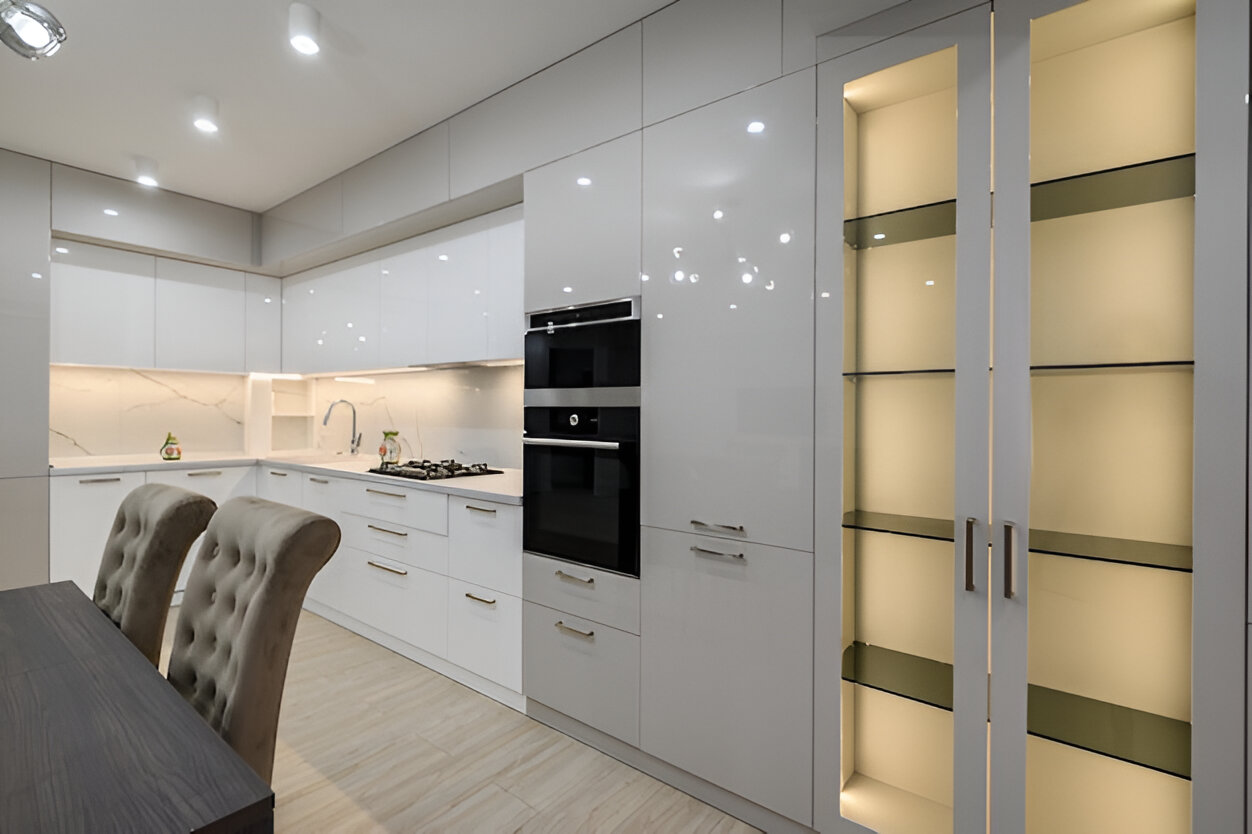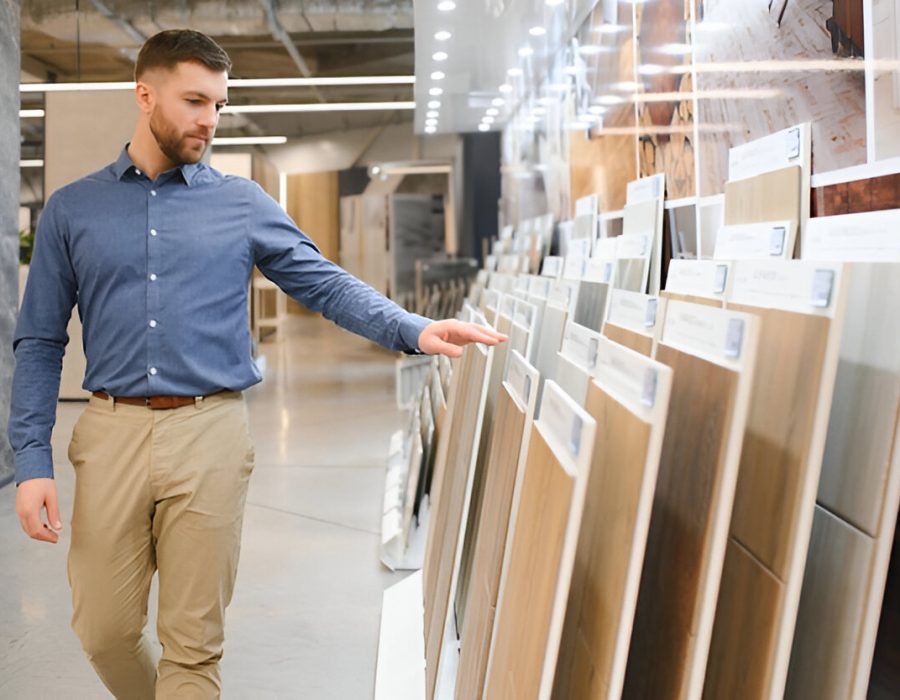The material of your kitchen cabinets is quite important when it comes to making a kitchen that looks good and works well. Kitchen cabinets do more than just hold things; they also set the mood for the whole kitchen. Choosing the right material for kitchen cabinets is quite important because they are such a key part of the design.
In this article, we’ll talk about the different kinds of materials used to make kitchen cabinets, their pros and cons, and how to get the most out of your money. You can get everything you need to make an informed choice, whether you’re replacing outdated cabinets or designing a new kitchen.
We’ll discuss new trends in kitchen cabinets such as the materials used for doors. We will also provide you with useful tips to make sure your look lasts.
Different Kinds Of Materials For Kitchen Cabinets
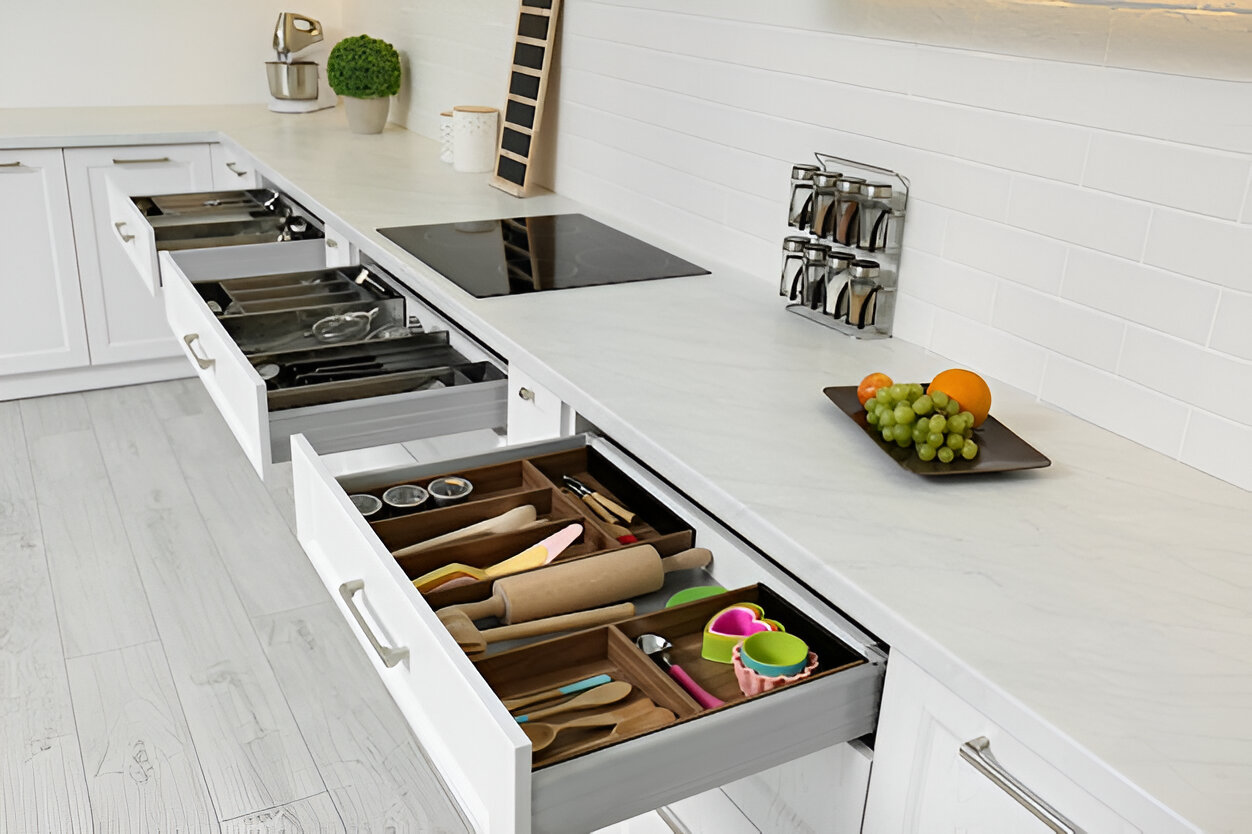
There are many different types of kitchen cabinets, each made of a different material. There is something for every budget and style, from classic wood to modern composite materials.
1- Kitchen Cabinets Made Of Plywood
Because it is made up of layers, plywood is frequently seen to be one of the best materials for kitchen cabinets. This makes it very strong and resistant to warping. Plywood is made by stacking thin layers of wood veneer. It does well in places where there is a lot of moisture, like kitchens.
Pros:
- Strong and long-lasting
- Light but strong
- Not likely to crack or shrink
- Great for making cabinets out of wood
Cons:
- Costs more than particleboard
- Needs to be sealed to keep out all moisture.
Plywood is becoming more and more popular in modern kitchens where homeowners want things to last. Check out our kitchen cabinet design ideas for more ideas on how to use plywood in your designs.
2- MDF (Medium-Density Fiberboard)
MDF is a type of engineered wood that is manufactured by breaking down fibers from both hardwood and softwood. It makes a smooth, even surface that is perfect for painted finishes, which makes it one of the most flexible forms of cabinet material. Many homeowners on a budget consider MDF one of the best materials for cabinet doors, especially if they prefer a smooth, painted finish.
Pros:
- The smooth surface is great for paint.
- Not as expensive as solid wood
- Not likely to crack
Cons
- Less resistant to dampness
- Can get scratched and dented easily
3- Solid Wood
Solid wood is a typical choice for high-end kitchen cabinets since it is naturally beautiful. Solid wood designs are commonly linked to types of wood used for cabinets, like oak, maple, cherry, and walnut. Solid wood is still a popular choice for kitchen cabinets, especially in rustic and traditional styles.
Pros:
- Always in style and classy
- Can be dyed for different looks
- Very long-lasting
Cons:
- It can warp when it’s humid
- More expensive than the designed options
4- Particleboard
Particleboard is cheap for kitchen cabinets since it is made of wood chips and resin.
Pros:
- Cheap, smooth surface.
Cons:
- Vulnerable to damage from water
- Not as hard as MDF or plywood
- Particleboard may not be the best choice for kitchen cabinets because it doesn’t last as long, but it’s a good choice for projects on a budget.
5- Cabinets with Laminate
Laminate is a man-made substance that is glued to plywood or MDF to make it look sleek and sophisticated.
Pros:
- A lot of different colors and textures
- Easy to clean
- Doesn’t stain easily
Cons:
- Likely to chip
- Not resistant to heat, laminate is great for people who want to blend modern style with usefulness.
6- Thermofoil
Thermofoil is a type of vinyl that is fused to MDF. It has a shiny, smooth finish that can look like more expensive materials.
Pros:
- Cheap
- Easy to clean
- Available in high-end looks
Cons:
- Can peel off when wet
- Not very durable
Want to look into more current materials? Think about looking at our kitchen cabinet color trends for ideas.
7- Steel That Doesn’t Rust
Stainless steel is one of the best high-end kitchen cabinet materials for people who want an industrial or ultra-modern style. Stainless steel cabinets are common in professional kitchens, but they are also becoming more popular in high-end household designs.
Pros:
- Very strong and long-lasting
- Waterproof all the way
- Not affected by bugs or rust
Cons:
- Costly
- Can display fingerprints and smudges
Kitchen Cabinet Materials Pros and Cons
Choosing the right cabinet materials involves weighing various factors like durability, cost, aesthetics, and high-end cabinet hardware. Here’s a quick comparison of the most common cabinet-building materials:
|
Material |
Pros |
Cons |
|
Plywood |
Strong, moisture-resistant | Expensive |
|
MDF |
Smooth finish, cost-effective |
Scratches easily |
|
Solid Wood |
Elegant, classic |
Expensive, warps in humidity |
|
Particleboard |
Affordable |
Not moisture-resistant |
|
Laminate |
Stylish, resistant to stains |
Prone to chipping |
|
Thermofoil |
Glossy finish, inexpensive |
Peels under moisture |
| Stainless Steel |
Durable, hygienic |
Expensive, shows fingerprints |
Along with these pros and cons, consider additional factors like maintenance and your kitchen’s exposure to wear and tear. If you’re browsing premium options, explore high-end kitchen cabinet materials.
Tips for Choosing the Right Material for Kitchen Cabinets
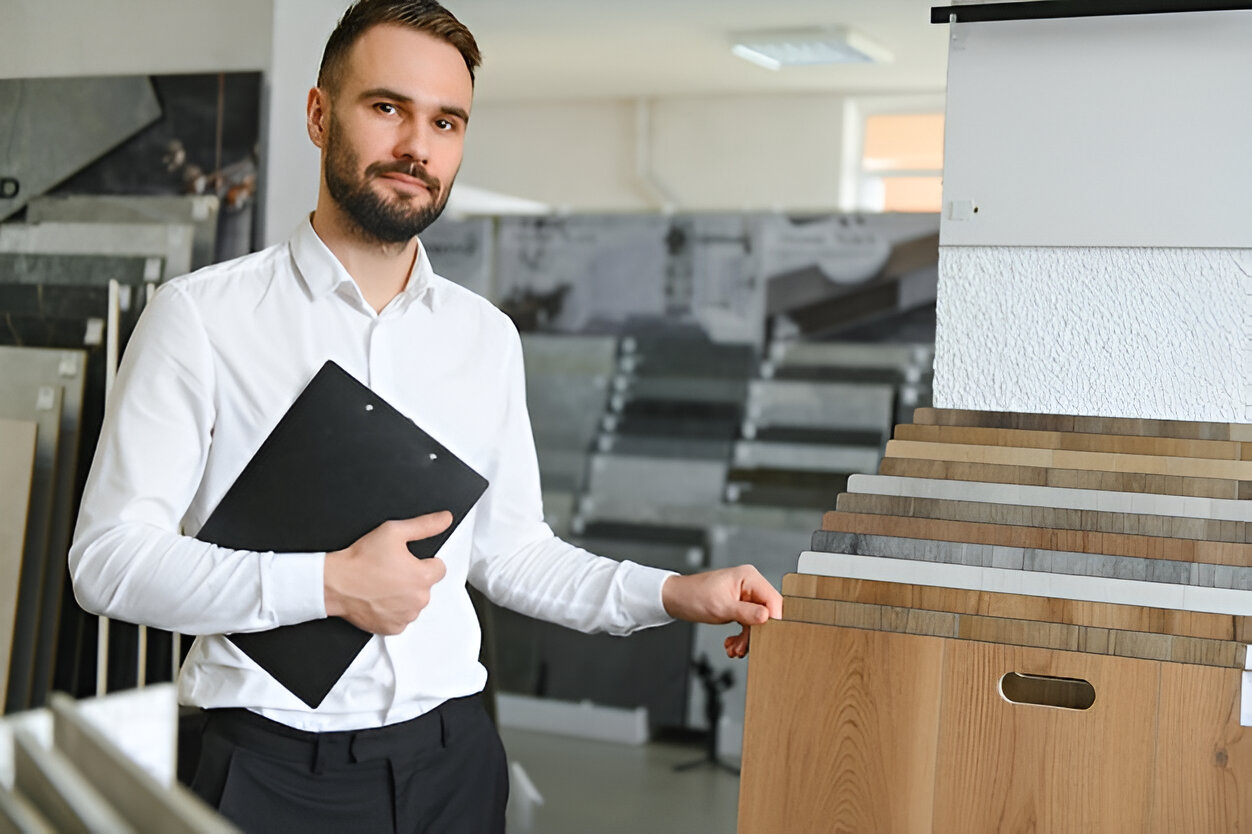
Here are some tips to ensure you pick a material that suits your lifestyle and budget:
Assess Durability
Families with young children or heavy kitchen use should prioritize robust options like plywood or solid wood.
Consider Moisture Resistance
For environments requiring maximum moisture resistance, prioritizing high quality steel from Bluescope over traditional wood ensures that the cabinetry remains impervious to the swelling and warping often caused by high humidity.
Plan Your Budget
For budget-friendly remodels, particleboard or MDF can be paired with stylish laminates or thermofoil finishes.
Match Aesthetic Preferences
The visual appeal of the material should align with your overall kitchen design. For color and style ideas, visit our blog on Kitchen Cabinet Brands.
Think Long-term
While some materials may have a higher upfront cost, they often save money in the long run due to their longevity.
How to Choose the Right Material for Your Home’s Cabinets
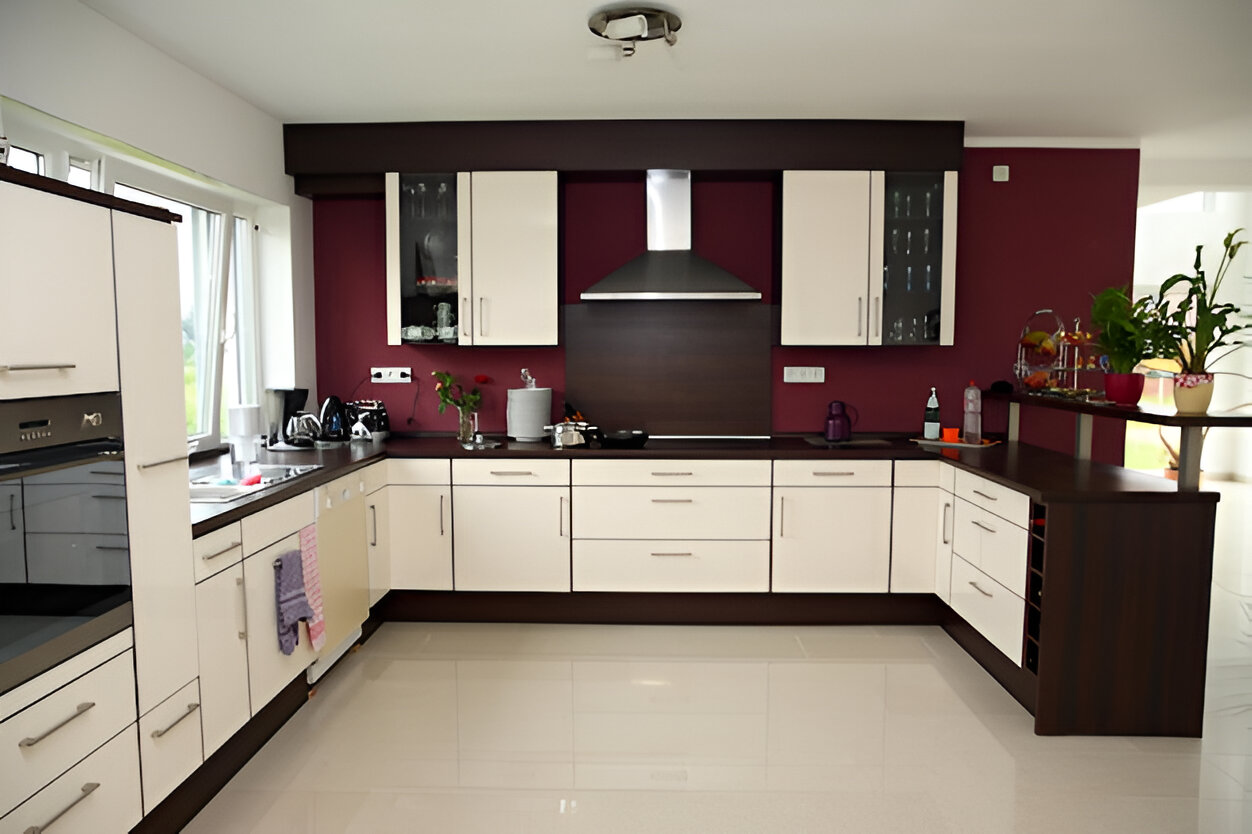
The material you choose for your cabinets is important for more than just how they look. It will determine how long they last, how easy they are to care for, and how well they work in your kitchen or bathroom for years to come. The type of cabinet material you choose has a big effect on both design and performance, whether you’re remodeling a modest area or building your ideal kitchen.
Think About How And Where It Will Be Used
Think about how the space will be used first. When you live in a place with a lot of moisture, like a kitchen or bathroom, it’s crucial to pick materials that can manage the humidity and regular cleaning. Plywood is a great choice in these situations since it is very resistant to damp and stays robust. Stainless steel is another moisture-resistant alternative, especially if you’re going for an industrial or futuristic aesthetic.
Consider The Style And How It Looks
Solid wood is a classic and long-lasting choice that provides natural warmth and value to your home for people who care about how it looks. It can be refinished several times, but it costs more and may need more care over time. If your design vision includes smooth, painted cabinet doors, then materials like Medium-Density Fiberboard (MDF) or High-Density Fiberboard (HDF) give a clean, consistent surface that’s great for painted finishes. They’re also more inexpensive than solid wood but less resistant to water damage.
Weigh the Budget Against Durability
If you’re dealing with a limited budget or furnishing a rental home, particleboard could be a tempting alternative due to its inexpensive cost. However, it lacks strength and is very vulnerable to swelling and sagging when exposed to dampness. It might work in places with little traffic or for short-term projects, but it’s not the best choice for kitchens that are used frequently.
Match the Material to Your Needs
Ultimately, the perfect cabinet material for your home will depend on your budget, lifestyle, and aesthetic goals. Think about how much use the cabinets will get, how often you want to clean or refinish them, and if you like a classic wood look or a more modern, sleek design. By analyzing these considerations carefully, you can make a wise and enduring investment that increases both the beauty and practicality of your room.
Exciting Trends in Kitchen Cabinet Materials
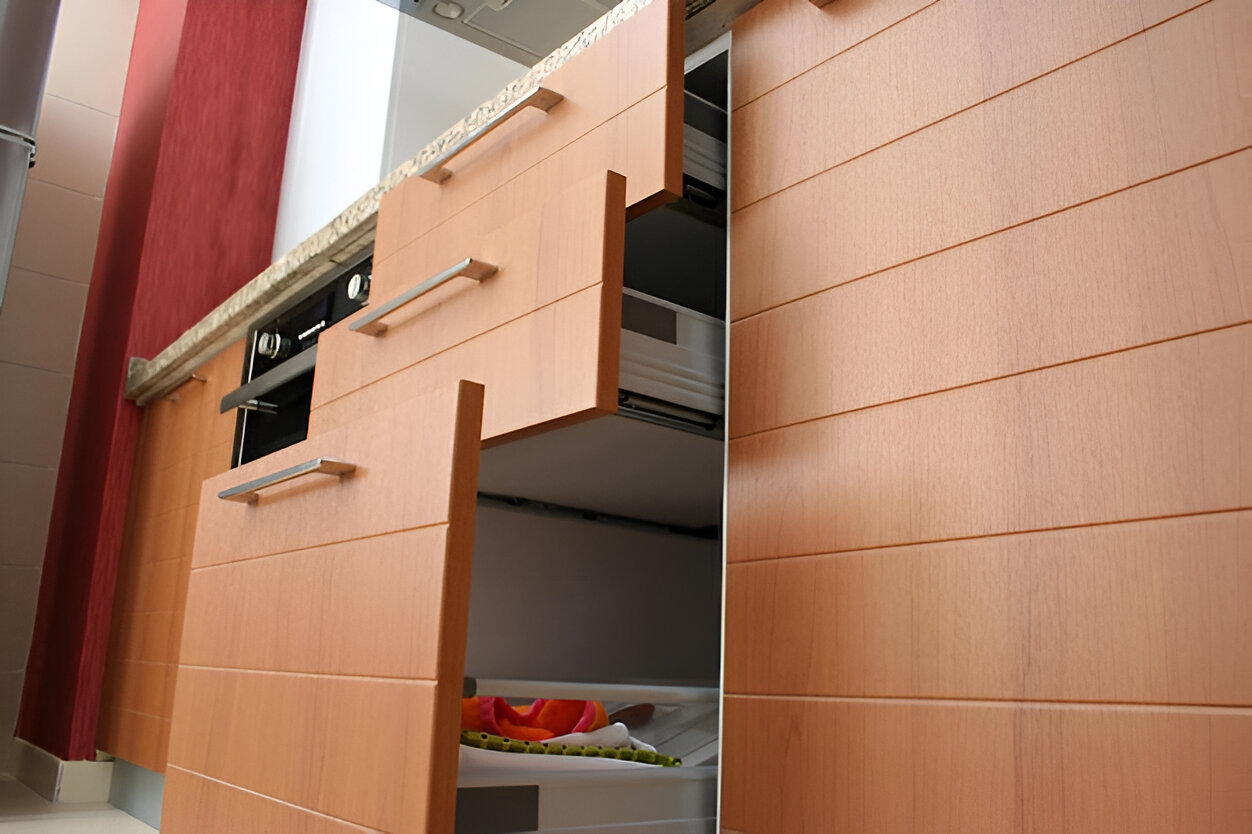
With the evolving priorities of modern homeowners and advancements in technology, today’s cabinet materials go beyond simple durability or aesthetics. Here are some key trends shaping the industry:
Sustainable Materials
Environmental awareness drives demand for eco-friendly materials like bamboo and reclaimed wood. Additionally, manufacturers are introducing composite materials incorporating recycled wood fibers or zero-VOC (volatile organic compounds) finishes to meet sustainability goals. Examples include bio-based resins and recycled wood particleboards.
Why It’s a Trend:
- Appeals to eco-conscious consumers
- Aligns with green certifications like LEED (Leadership in Energy and Environmental Design)
Smart Materials and Technologies
Emerging materials are also integrating smart features for better functionality and user experience. Here are some examples:
- Magnetic Surfaces: Cabinets with built-in magnetic layers allow for the easy attachment of organizers or kitchen accessories.
- Self-Healing Surfaces: Thermo-repair films can recover from micro-scratches or minor dents with exposure to heat or steam, a concept that parallels more heavy-duty structural repair techniques like resin injection used in concrete.
- Antibacterial Laminates: These surfaces are treated to inhibit microbial growth, making them ideal for hygienic kitchen environments.
Why It’s a Trend:
- Adds value through functionality
- Caters to tech-savvy and health-conscious homeowners
- Extends the product’s lifespan, reducing long-term costs
Frequently Asked Questions About Kitchen Cabinet Materials
What is the best material for kitchen cabinets overall?
The answer depends on your budget, maintenance preferences, and design style. Plywood is often considered the best overall material for kitchen cabinets due to its combination of strength, moisture resistance, and longevity.
Which is the best material for cabinet doors?
For cabinet door materials, solid wood and laminate are popular choices. Solid wood offers timeless beauty, while laminate is perfect for modern styles.
Are there eco-friendly cabinet material types?
Yes! Bamboo and reclaimed wood are sustainable options for environmentally conscious homeowners.
Final Thoughts
Whether you’re drawn to the elegance of natural wood or the modern appeal of laminate, selecting the right kitchen cabinet material is critical to building your dream kitchen. By understanding the pros and cons of each option, you’ll make a choice that balances style, durability, and functionality.
If you’re ready to bring your design ideas to life, don’t forget to visit Badger Cabinets for high-quality materials and expert solutions. Make your kitchen a space you’ll love for years to come!


